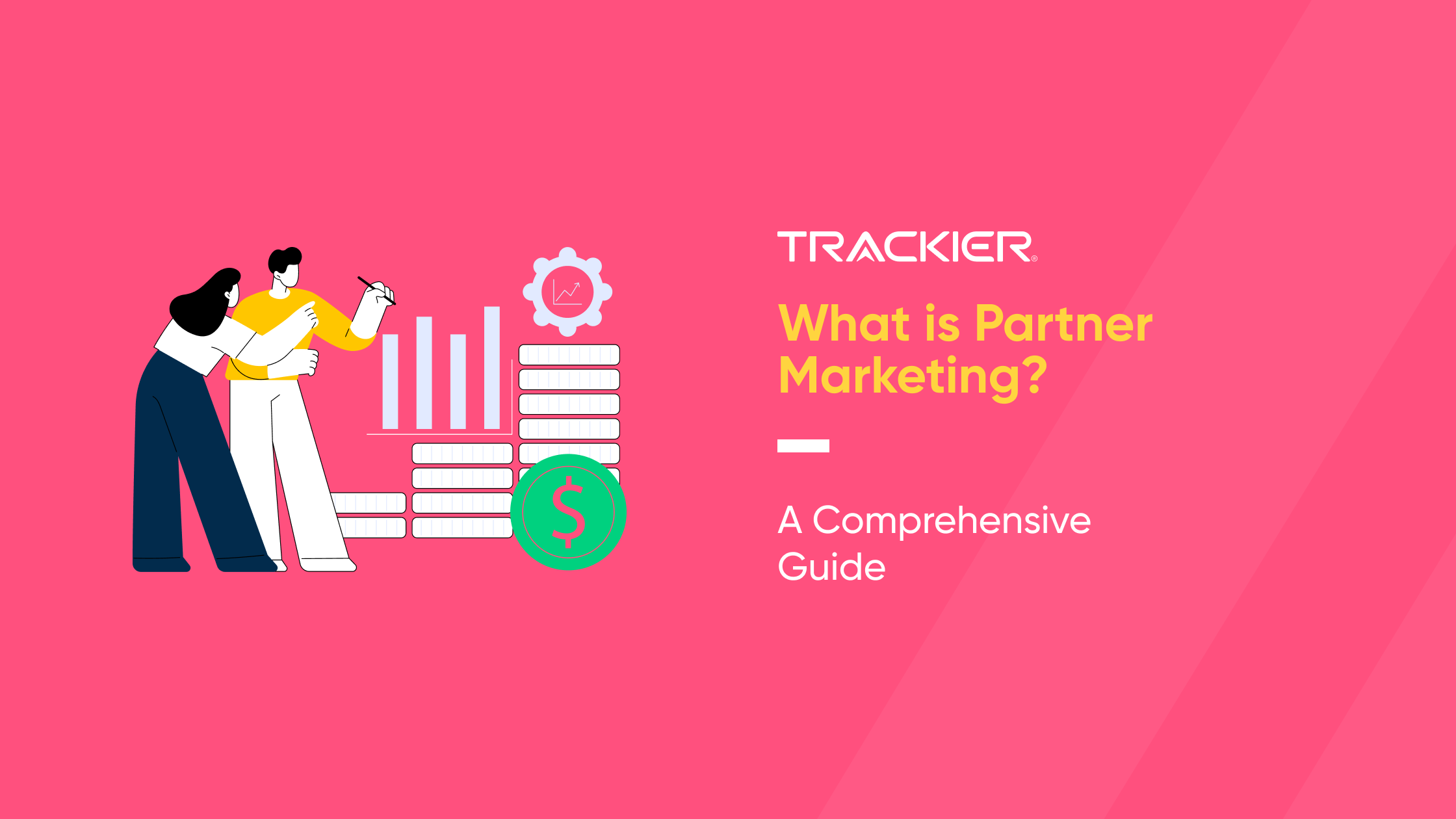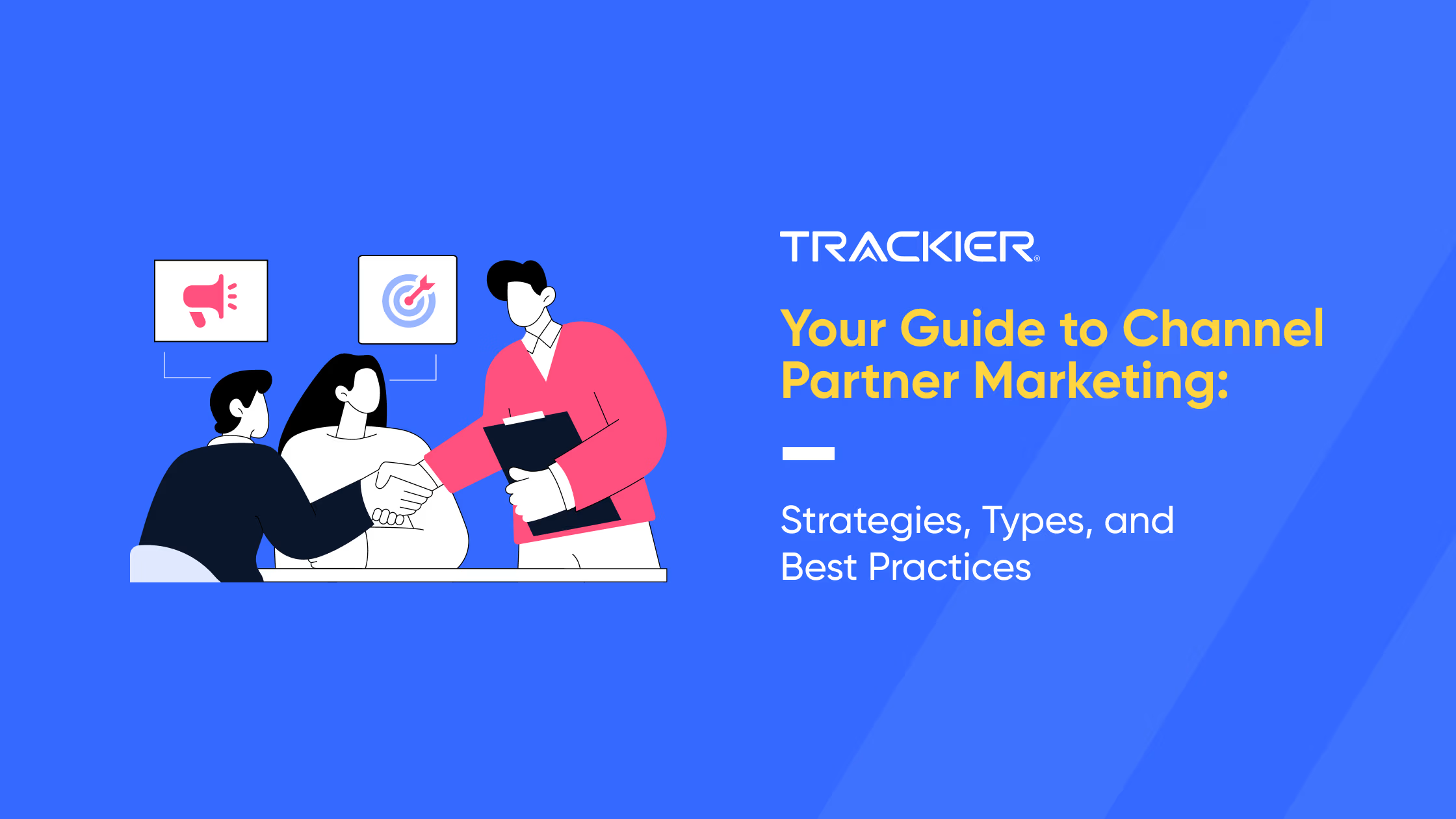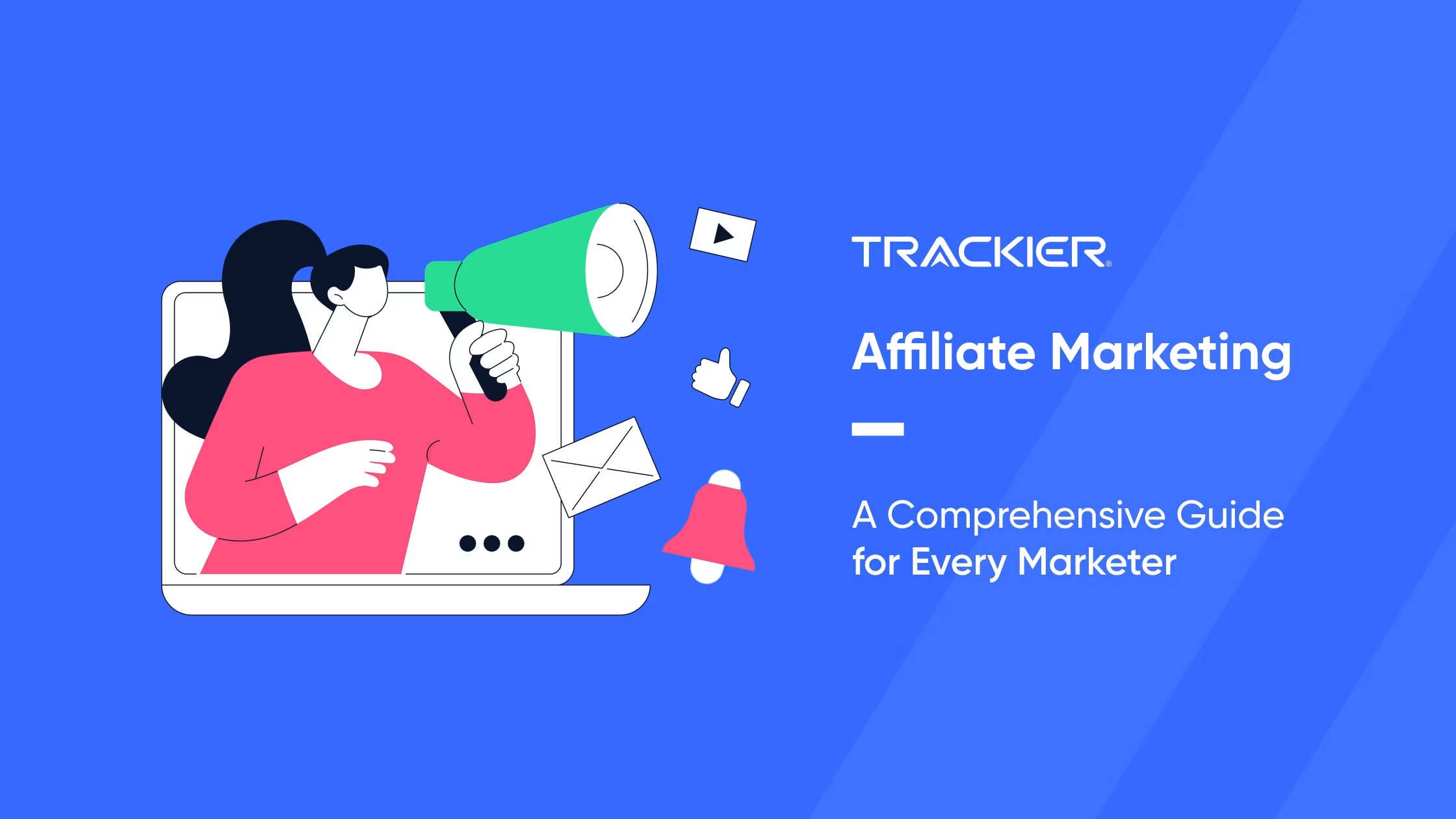Standing out in a digitally saturated marketplace isn’t just about big advertising budgets or viral social campaigns, it’s about building strategic relationships that create a lasting impact. As organizations of all sizes seek ways to drive more meaningful engagement, lower acquisition costs, and scale their efforts efficiently, one powerful growth engine has risen to the forefront: Partner Marketing.
Partner Marketing is a high-leverage, collaborative marketing strategy where two or more brands join forces to co-market products, share audiences, co-create content, and drive measurable results together. It’s a model built on trust, synergy, and mutual benefit, allowing brands to tap into each other’s strengths, credibility, customer base, and channels to accelerate business outcomes.
Think of it this way: instead of going it alone, you team up with others who have complementary offerings, shared goals, or aligned customer profiles. Whether it’s through affiliate marketing, influencer collaborations, referral partnerships, technology integrations, loyalty tie-ins, or channel programs, partner marketing can take many forms, but its objective remains the same: maximize growth through collective action.
Why does this matter now more than ever? Because the landscape of digital marketing has fundamentally changed.
- Customer acquisition costs (CAC) have soared, making it increasingly difficult to grow profitably through paid ads alone.
- Consumer trust is shifting; buyers today rely more on peer recommendations, trusted influencers, and brand ecosystems than traditional marketing messages.
- The market is fragmented, and attention spans are short, making it hard for single-brand campaigns to break through and sustain engagement.
- Data privacy regulations and restrictions on third-party cookies have made it tougher to target and retarget audiences effectively.
In this new reality, businesses need smarter, more integrated strategies. Partner marketing offers exactly that, a scalable way to build reach, amplify brand authority, and boost conversion rates without relying solely on internal resources. From B2B SaaS companies aligning with complementary platforms to D2C brands co-launching campaigns with creators or affiliate networks, the possibilities are vast and incredibly versatile.
But this isn’t just about tactics. It’s a mindset. Partner marketing requires a shift from transactional thinking to relationship-driven growth. It’s about investing in shared success, co-creating value, and fostering long-term partnerships that go beyond one-off promotions.
In this comprehensive guide, we’ll walk you through the full spectrum of partner marketing, from the fundamental definitions and models to the tangible benefits, real-world use cases, technology frameworks, and future trends shaping this space. Whether you’re new to partnerships or scaling an existing ecosystem, this guide will serve as your blueprint for unlocking the full potential of collaborative marketing.
Let’s dive in and explore how partner marketing can become the cornerstone of your sustainable, scalable, and strategic growth in today’s competitive digital economy.
The Fundamentals of Partner Marketing
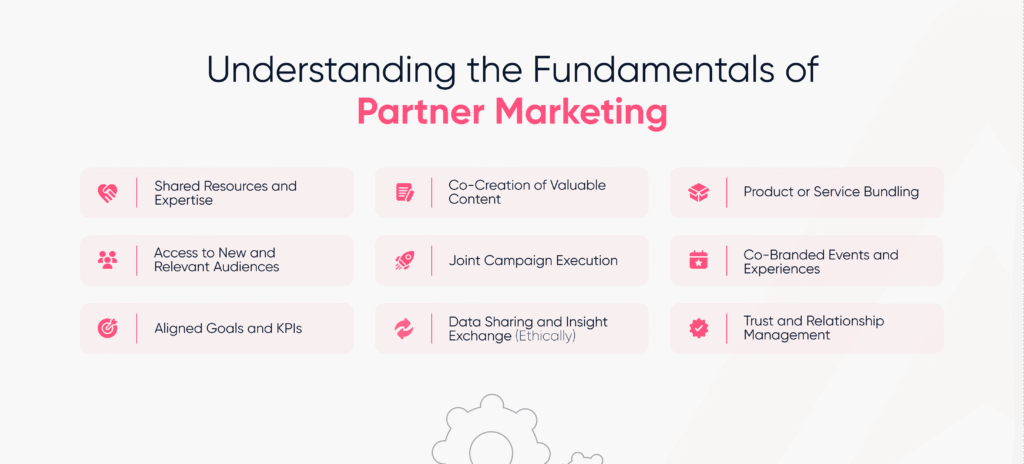
As we know, partner marketing is all about brands teaming up to hype their goods or services to the same crowd, more like a power duo working the scene together. This isn’t limited to big corporations. Startups, mid-market players, and even solopreneurs use partnerships to tap into new markets, boost credibility, reduce marketing costs, and enhance customer experiences.
What Makes It Work?
At its core, partner marketing thrives on mutual value creation. Unlike transactional vendor relationships, true partner marketing is built on trust, aligned objectives, complementary strengths, and a clear understanding of how both parties can grow together. Here’s a deep dive into the elements that make partner marketing successful:
1. Shared Resources and Expertise
Partners pool together not just their budgets, but their capabilities, infrastructure, and know-how. One partner may bring content marketing strength, while the other offers deep industry connections or technical prowess. By combining these assets, both can create a richer, more effective marketing strategy than either could manage alone.
2. Access to New and Relevant Audiences
One of the biggest advantages of a strategic partnership is audience access. Rather than building a new audience from scratch, each partner gets instant visibility in front of a pre-qualified and often highly engaged customer base. This leads to more efficient lead generation and higher conversion rates, since the trust factor is already embedded via association.
3. Aligned Goals and KPIs
The best partnerships are formed when both companies have complementary goals, such as entering a new market, boosting brand awareness, launching a new product, or increasing customer engagement. Clearly defined KPIs (like leads generated, event registrations, or social media reach) help measure success and keep both sides accountable.
4. Co-Creation of Valuable Content
From whitepapers and webinars to eBooks and podcasts, co-branded content provides unique value to shared audiences. Content co-creation strengthens thought leadership, drives SEO performance, and multiplies content distribution power across channels—essentially doubling visibility with half the work.
5. Joint Campaign Execution
Running joint marketing campaigns, email sequences, performance ads, influencer activations, or social media contests maximizes each partner’s media spend efficiency and tactical creativity. Campaigns become more engaging when they reflect a synergy of voices, perspectives, and benefits.
6. Data Sharing and Insight Exchange (Ethically)
When partners agree to share aggregated, anonymized customer data, it leads to sharper targeting, better messaging, and more personalized experiences. Additionally, sharing insights like content performance, buyer behavior, or market feedback can fine-tune future campaigns and drive continuous improvement.
7. Product or Service Bundling
Bundling offerings from two (or more) partners into a single package adds value for customers and creates unique propositions that competitors may struggle to match. It’s especially powerful in SaaS, fintech, and eCommerce ecosystems where integrations or bundled pricing can directly impact acquisition and retention.
8. Co-Branded Events and Experiences
Whether it’s a virtual webinar, live roundtable, workshop, or trade show, co-hosted events help create memorable experiences that build deeper connections with customers. Events offer a platform for joint storytelling, real-time audience engagement, and brand alignment in a highly visible setting.
9. Trust and Relationship Management
All the tactics above will fall flat without open communication, transparency, and mutual respect. Regular check-ins, performance reviews, and honest feedback loops ensure that the partnership stays healthy, adaptive, and aligned as market conditions evolve.
When partner marketing is done right, it becomes a force multiplier, delivering results that are exponentially greater than what each brand could achieve independently. Instead of competing for attention, partners collaborate to command it, driving sustainable growth through cooperation over competition.
When executed well, both partners benefit from expanded reach, amplified trust, and higher ROI without doubling costs.
Partner Marketing And It’s Types
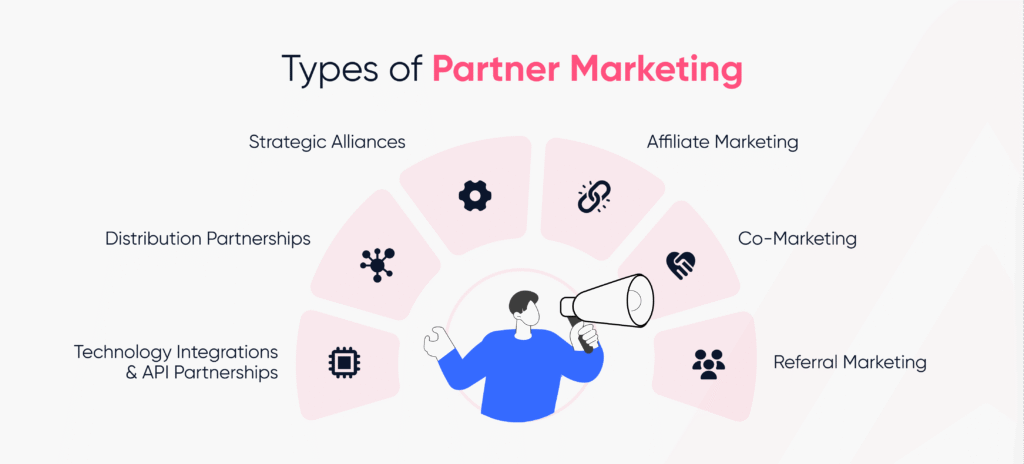
Partner marketing isn’t a monolithic concept. It branches into multiple models:
1. Affiliate Marketing
A results-driven model where partners earn a commission for promoting a brand. Affiliates use tracking links to send traffic, and they are paid per lead, sale, or click.
2. Co-Marketing
Two brands jointly create and promote a campaign. For example, a SaaS company and a digital agency might co-host a webinar or co-author an eBook.
3. Referral Marketing
Here, businesses encourage existing customers or partners to refer new customers. These referrers are usually rewarded with perks or monetary incentives.
4. Strategic Alliances
Long-term collaborations where two companies align their long-term marketing or business strategies. Think Apple and Nike, Uber and Spotify.
5. Distribution Partnerships
This involves resellers, value-added distributors, and retail alliances that market and sell your product within their channels.
6. Technology Integrations & API Partnerships
SaaS companies often integrate their tools with other platforms to improve user experience and generate co-marketing opportunities.
Why Partner Marketing Works
1. Extended Reach with Lower Costs
Building your audience takes time and capital. A partner already has an engaged customer base. Partnering allows you to reach new audiences faster and more affordably.
2. Enhanced Credibility
Trust is a key currency in marketing. When a respected brand recommends your product, that trust is transferred. This is especially valuable in B2B and emerging markets.
3. Resource Sharing
Partner marketing often involves shared costs for ads, tools, and content production. You get twice the firepower without doubling the budget.
4. Faster Market Penetration
Launching in a new region or vertical? Partnering with a local or specialized brand offers instant access and relevance.
5. Increased Lifetime Value (LTV)
Bundled offerings or integrations make customers more likely to stick around. Plus, partners can help with onboarding, support, and upselling.
Steps Of The Partner Marketing Process
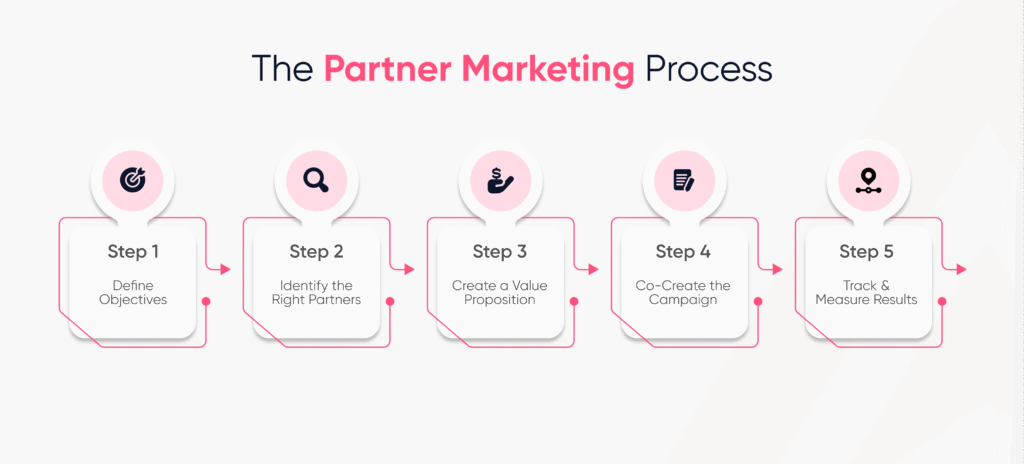
Creating a partner marketing program isn’t plug-and-play. It requires careful planning, execution, and evaluation. Here’s a breakdown:
Step 1: Define Objectives
What do you want from a partnership? Leads, sales, brand awareness, and content assets? Be specific.
Step 2: Identify the Right Partners
Choose partners who:
- Serve a similar audience, but don’t directly compete
- Have complementary products/services
- Share similar values
- Have marketing capabilities and intent
Step 3: Create a Value Proposition
What’s in it for them? Offer a win-win deal with clear benefits.
Step 4: Co-Create the Campaign
Collaborate on:
- Messaging
- Design assets
- Channels (email, social, events)
- Budget allocation
- Promotion timelines
Step 5: Track & Measure Results
Use UTM parameters, Trackier dashboards, or custom analytics to monitor:
- Click-through rates
- Leads generated
- Conversion rates
- Engagement levels
Tools That Power Partner Marketing
Successful partner programs are built on strong foundations. Tools like Trackier offer a unified platform to:
- Track referrals and commissions
- Automate partner onboarding and communication
- Prevent fraud
- Analyze performance in real-time
- Customize dashboards for each partner
With such a system, marketers save hours in spreadsheets, reduce errors, and increase transparency for all parties involved.
Trackier’s Role in Scaling Partner Marketing
Trackier is purpose-built to empower performance marketers, advertisers, and agencies with powerful tracking and attribution capabilities.
Key features include:
- Affiliate & partner management
- Multi-channel tracking
- Real-time reporting
- Custom payouts
- Campaign automation
It’s not just about managing partnerships. It’s about optimizing every aspect of partner engagement to drive scalable ROI.
Common Pitfalls & How to Avoid Them
Even the most experienced marketers can run into trouble when executing partner marketing strategies. While partnerships hold immense growth potential, missteps can lead to wasted resources, strained relationships, or even reputational damage. Understanding the most common pitfalls and how to proactively avoid them is key to running a successful partner marketing program.
1. Misaligned Goals
One of the most frequent issues in partner marketing stems from a disconnect in objectives. If one partner is focused on brand awareness while the other is aiming for direct lead generation, the campaign can fall flat despite best efforts. Misaligned KPIs often result in miscommunication, disappointment, and missed expectations.
How to Avoid It:
Start with a strategic alignment session where both partners articulate their individual goals, target audiences, and definitions of success. Define joint KPIs (e.g., shared conversions, engagement metrics, customer acquisition cost) and document them formally. These metrics should be revisited periodically to ensure both teams remain on the same page as campaigns evolve.
2. Poor Communication
Partnerships thrive on transparency and timely updates. Without structured communication, teams can quickly lose sight of progress, responsibilities, or campaign changes. This leads to missed deadlines, duplicated efforts, or inconsistent messaging.
How to Avoid It:
Establish a clear communication rhythm from the outset. This can include weekly check-ins, shared Slack or Microsoft Teams channels, and collaborative tools like Notion or Trello to manage deliverables. Consider creating a shared dashboard with real-time performance metrics using tools like Trackier to maintain visibility and accountability.
3. Unbalanced Contributions
An unbalanced partnership, where one party shoulders most of the workload or investment, can quickly sour, leading to frustration or disengagement. This issue often arises when roles are vaguely defined or when partners operate with different capacities and expectations.
How to Avoid It:
Clearly define each partner’s role in the project with measurable responsibilities. Whether it’s content creation, paid media budget, influencer outreach, or email list sharing, ensure both sides are contributing fairly in proportion to the benefits they receive. Formal agreements or memoranda of understanding (MoUs) can reinforce accountability and mutual respect.
4. Lack of Tracking and Attribution
Without proper tracking mechanisms, it’s difficult to measure campaign effectiveness or attribute results to specific actions. This not only undermines optimization efforts but can also create disputes about lead ownership or commission payouts.
How to Avoid It:
Invest in a robust tracking platform like Trackier, which is designed specifically for partner and performance marketing. These tools allow you to set up custom tracking links, monitor clicks, conversions, and even set up tiered commission structures. Accurate data attribution ensures transparency, trust, and optimized campaign performance.
5. Neglecting Legal and Compliance Aspects
Legal issues can derail even the most well-intentioned partnerships. Common mistakes include failing to define intellectual property ownership, overlooking privacy regulations, or not outlining dispute resolution procedures.
How to Avoid It:
Engage legal counsel early and develop comprehensive partnership agreements. These contracts should cover IP rights, data usage permissions, exclusivity clauses (if any), compensation models, exit strategies, and dispute resolution methods. This is especially critical when working across different jurisdictions or industries with unique compliance requirements, such as finance, healthcare, or telecom.
Real-World Examples
- Spotify + Uber: Passengers could control the music during Uber rides using Spotify.
- GoPro + Red Bull: The brands co-created extreme sports events and viral content.
Even small businesses can emulate these strategies through local business alliances, tech integrations, or influencer partnerships.
Partner Marketing And Its Future
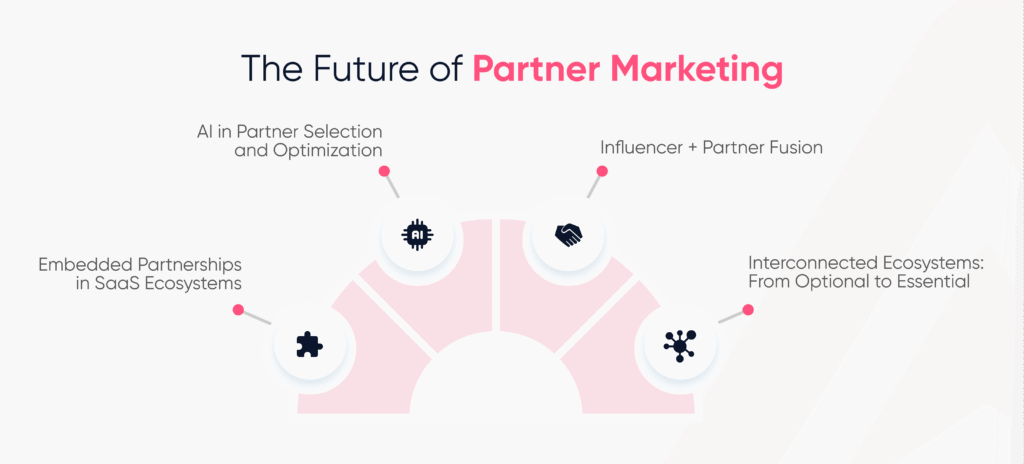
The landscape of partner marketing is undergoing a rapid transformation, driven by new technologies, evolving consumer expectations, and the growing complexity of digital ecosystems. Traditional partner programs, once rooted in manual outreach, static agreements, and fixed KPIs, are giving way to a more fluid, tech-augmented model that emphasizes agility, intelligence, and co-innovation. Let’s explore four key trends shaping the future of partner marketing:
1. AI in Partner Selection and Optimization
Artificial Intelligence (AI) is revolutionizing how brands identify, evaluate, and engage with partners. Advanced platforms like Trackier are at the forefront of this transformation, leveraging machine learning algorithms to sift through vast datasets and pinpoint high-performing affiliates, influencers, and content partners with precision.
AI does more than just match partners, it predicts performance. It analyzes historical data, campaign behavior, audience overlap, and conversion efficiency to forecast which partnerships will yield the best return. This predictive capability reduces guesswork and accelerates decision-making, enabling marketers to launch smarter campaigns, faster.
Additionally, AI-powered tools automate performance optimization by adjusting commission structures, reallocating budget, and flagging anomalies in real time. As a result, partner marketing becomes a dynamic, data-driven engine rather than a static program.
2. Influencer + Partner Fusion
The lines between affiliate, partner, and influencer marketing are blurring. Influencers, once seen as one-off brand amplifiers, are now evolving into long-term strategic partners. This fusion is redefining the nature of collaborations.
Rather than just promoting products for a fee, today’s top-tier influencers co-create content, share revenue, and contribute insights to product development. Their value lies not just in their reach but in their trust-based relationship with niche audiences. When combined with performance-based tracking, these relationships become powerful growth levers.
Brands are building hybrid programs that blend influencer authenticity with affiliate accountability, tracking metrics like clicks, conversions, and lifetime customer value. The result? Sustainable partnerships that go beyond vanity metrics and drive real business outcomes.
3. Embedded Partnerships in SaaS Ecosystems
In the software-as-a-service (SaaS) world, partner marketing is no longer a bolt-on strategy, it’s embedded into the product itself. Leading SaaS platforms are building deep integrations with complementary tools, creating sticky ecosystems where partners become essential extensions of the core offering.
For example, integrations with CRM systems, payment gateways, analytics tools, and affiliate platforms like Trackier enable users to experience seamless workflows while partners gain consistent visibility and engagement. These embedded partnerships foster mutual dependence, leading to higher retention and joint innovation.
This model extends to co-branded solutions, joint go-to-market campaigns, and marketplace listings where SaaS companies and partners co-own customer relationships. In such environments, partnerships aren’t just beneficial, they’re vital to scale.
4. Interconnected Ecosystems: From Optional to Essential
As businesses become more interconnected, operating in silos is no longer right. The future of growth lies in ecosystems, networks of interconnected companies that collaborate to solve customer problems holistically.
In this context, partner marketing shifts from a tactical program to a strategic imperative. It’s about building alliances that complement your strengths, extend your reach, and deepen your value proposition.
With APIs, real-time data sharing, and unified dashboards, partners can now collaborate more effectively than ever before. Whether it’s cross-promotional campaigns, bundled offerings, or co-hosted events, the ability to work fluidly across organizations is becoming a key competitive advantage.
In short, partner marketing isn’t just evolving, it’s becoming fundamental. Businesses that fail to embrace this shift risk falling behind in a world where collaboration is the new currency of growth.
As ecosystems grow more interconnected, partner marketing isn’t optional; it’s fundamental.
Final Thoughts: Is Partner Marketing Right for You?
If you’re looking to:
- Expand without exploding your budget
- Increase conversion rates
- Scale into new markets
- Improve retention
…then yes, partner marketing is worth your attention. Success isn’t accidental, it’s built. It takes strategic alignment, a solid framework, and the right platform to power it all. That’s where Trackier comes in, bringing structure and scalability to your partner marketing efforts. When done right, the payoff is big: sustainable growth and lasting brand equity. So, are you ready to unlock the full potential of partner marketing? Your journey starts today.
FAQs
What is the difference between partner marketing and affiliate marketing?
Affiliate marketing is a subset of partner marketing where individuals or publishers promote products and earn commissions based on performance. Partner marketing, on the other hand, encompasses a broader spectrum of collaborations, such as co-marketing, strategic alliances, and referral programs, focused on shared goals and long-term value creation between brands.
How do I choose the right partner for my marketing campaign?
Choosing the right partner involves evaluating audience overlap, brand alignment, complementary offerings, and mutual goals. Ideal partners should enhance your value proposition and be willing to co-invest in campaign efforts. It’s also important to assess their marketing capabilities, communication transparency, and overall credibility before entering into any collaboration.
What are some examples of successful partner marketing?
Great examples include Uber and Spotify’s in-app music integration, GoPro and Red Bull’s extreme sports content partnership, and Starbucks and Barnes & Noble’s in-store café collaboration. These partnerships succeeded because they aligned customer interests, co-created unique experiences, and leveraged each other’s brand power to reach wider, more engaged audiences.
How can I measure the ROI of partner marketing?
ROI can be measured using key performance indicators like leads generated, customer acquisition cost (CAC), sales conversions, engagement metrics, and partner-influenced revenue. Attribution tracking helps determine which partner activities drive results. Comparing performance data against initial goals ensures transparency and allows for ongoing optimization of the program.
What tools do I need to run a partner marketing program?
Running an effective partner program requires tools for partner onboarding, campaign tracking, performance analytics, communication management, and payout automation. These tools streamline operations, reduce manual errors, and allow you to track performance in real-time, making it easier to scale efforts and ensure consistent partner engagement.
Is partner marketing suitable for B2B businesses?
Yes, partner marketing is highly effective in B2B. From co-hosted webinars and joint whitepapers to referral alliances and software integrations, B2B brands benefit from access to new audiences, shared expertise, and enhanced trust. Strategic partnerships can also accelerate market entry, improve lead quality, and strengthen brand authority in niche sectors.
